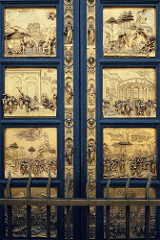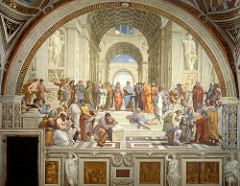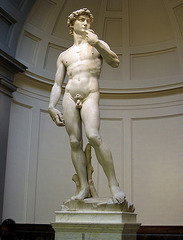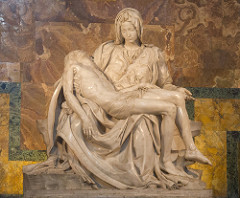Italian Renaissance
the revival of ancient learning and the supplanting of traditional religious beliefs by new secular and scientific values that began in Italy in the fourteenth and fifteenth centuries
Jacob Burckhardt
Civilization of the Renaissance in Italy (1860), argued that the revival of ancient learning in 14th and 15th century Italy gave rise to new secular and scientific values. He saw the Renaissance as the birth of modernity.
City-States
During the 14th and 15th century, these powerful entities emerged in Italy, dominating the political and economic life of the surrounding countryside. They were not united, and often fought with each other. Consisted of the Duchy of Milan, Republic of Genoa, Republic of Florence, Republic of Venice, Papal States, ad the Kingdom of Naples.
Signori (Signoria)
A council, first of six, and later of eight members, governed the city of Florence. The men were chosen from the most powerful guilds, namely, those representing the major clothing industries. Cosimo de Medici used this group to keep a firmer grip on his power.
Oligarchies
rule of merchant aristocracies, controlled much of Italy by 1300
Commenda System
Contract between merchant and
“merchant-adventurer” who agreed to take goods to
distant locations and return with the proceeds (for 1/3
of profits)
Condottieri
Mercenary armies obtained through military brokers, controlled by despots
Republic of Florence
A moderately large Italian city that was central to the Italian Renaissance because of its gifted individuals; Dante, Pretrach, Boccaccio, Machiavelli, Brunelleschi, Donatello, Masaccio, Boticelli and others. The city was ruled by the Medici familly, a family of great wealth. Still, the city continued to produce new ways of thinking and helped progress the Renaissance further.
Medici Family
Ruled Florence during the Renaissance, became wealthy from banking, spent a lot of money on art, controlled Florence for about 3 centuries
Cosimo de’ Medici
the wealthiest Florentine and an astute statesman, he brought stability back to Florence in 1434 when he ascended to power; controlled the city internally from behind the scenes, skillfully manipulating the constitution and influencing elections; through his informal, cordial relations with the electoral committee, he was able to keep councilors loyal to him in the Signoria (the governing body of Florence, composed of 8 councilors); as head of the Office of Public Debt, he was able to favor congenial factions; He was the grandfather of Lorenzo the Magnificent
Duchy of Milan
Ruled by Sforza Family after 1450; Milan was a principal adversary of Venice and Florence until the Peace of Lodi created a relative 40- year period of peace among the Italian city states
Sforza Family
Milanese family who, through despotism, came to power in 1450; ruled without constitutional restraints or serious political competition; produced one of Machiavelli’s heroes, Ludovico il Moro
Republic of Venice
Longest lasting of the Italian states because it did not succumb to foreign powers until Napoleon. Also one of the world’s great naval and trading powers during the 14th and 15th centuries
Papal States
A group of territories in central Italy ruled by the popes from 754 until 1870. They were originally given to the papacy by Pepin the Short and reached their greatest extent in 1859. The last papal state—the Vatican City—was formally established as a separate state by the Lateran Treaty of 1929.
Naples, Kingdom of the Two Sicilies
Only Italian city state to officially have a “king”
Charles VIII
French King who responded to Ludovico’s call for help and invaded Italy. Conquered Florence, Papal States, Naples.
Girolamo Savonarola
Became the unofficial leader of Florence between 1494-1498 who pledged to rid Florence of its decadence and corruption, oversaw a theocracy in Florence. When France was removed from Italy in 1498, Savonarola was imprisoned and then burned at the stake.
The Prince
A short political treatise about political power how the ruler should gain, maintain, and increase it. Machiavelli explores the problems of human nature and concludes that human beings are selfish and out to advance their own interests
Cesare Borgia
younger son of Pope Alexander VI, prototype of Niccolò Machiavelli’s Prince —intelligent, cruel, treacherous, and ruthlessly opportunistic, wanted to unite Italy under his control
Sack of Rome
1527, Charles I sacked Rome, ended the Italian wars, ended the High Renaissance, began the Late Renaissance
Charles V
Holy Roman emperor (1519-1558) and king of Spain as Charles I (1516-1556). He summoned the Diet of Worms (1521) and the Council of Trent (1545-1563), tried to crush the Reformation by use of the Counter-Reformation
Humanism
the study of the Latin and Greek classics and of the Church fathers both for their own sake and to promote a rebirth of ancient norms and values
Civic Humanism
humanism with the added belief that one must be an active and contributing member to one’s society
Petrarch
(1304-1374) Father of the Renaissance. He believed the first two centuries of the Roman Empire to represent the peak in the development of human civilization.
Decameron
Boccaccio’s stories about the plague in Florence
Leonardo Bruni
Florentine who first gave the name humanitas, or “humanity”, to the learning that resulted from such scholarly pursuits as Studia Humanitatis
Lorenzo Valla
(1406-1457) On Pleasure, and On the False Donation of Constantine, which challenged the authority of the papacy. Father of modern historical criticism.
Elegances of the Latin Language
This work truly embodied the ideas of its author, Lorenzo Valla, by revealing the explosive character of the new learning.
On the False Donation of Constantine
Lorenzo Valla’s analysis and critique of an 8th century document that established papal authority over western Europe, proved that the worked attributed to Constantine was not real
Latin Vulgate
created by Jerome, first Bible able to be read by the common people as it was written in the vernacular
Marsilio Ficino
Founded the Platonic Academy at the behest of Cosimo de’ Medici in the 1460s. Translated Plato’s works into Latin, giving modern Europeans access to these works for the fist time.
Oration of the Dignity of Man
This work, by Pico della Miandola, is regarded as the most famous Renaissance statement on the nature of humankind. It drew on Platonic teaching to depict humans as the only creatures on earth who possessed free will and could chose to become angels or pigs.
Book of the Courtier
This was a book written by Castiglione. In it, he epitomized the main ideas of Italian humanism. It said a successful man was one who could integrate knowledge of ancient languages and history w/ athletic, musical, and military skillz, all while being polite and exhibiting a high moral character.
Virtu
The striving for excellence and being a virtuous person. Humanistic aspect of Renaissance.
Johannes Gutenberg
German printer who was the first in Europe to print using movable type and the first to use a press (1400-1468)
Quattrocento
Italian, literally “four hundred”; it refers to the 1400s— the fifteenth century, especially in reference to Italian art of this time (the late Middle Ages and Early Renaissance).
Giorgio Vasari
Italian painter and art historian (1511-1574); wrote The Lives of the Artists. Massive patronage of the arts came from this and was lead by families like the Medici’s and also the churches, who saw art as a means of glorifying God.
Cinquecento
the 1500s; the High Renaissance in Rome; art was becoming more secular
Pope Alexander VI
Pope and father of Cesare Borgia and Lucrezia Borgia (1431-1503), corrupt Spanish Renaissance pope, took over control of the Papal States
Perspective
the appearance of things relative to one another as determined by their distance from the viewer
Chiaroscuro
the use of shading to enhance naturalness in Renaissance painting
Stylized Faces
medieval faces in art–more stylized and generic
Sfumato
Painting technique in which contours are enveloped in a suggestive, smoke-like haze
Contrapposto
Human posture in which the shoulders and head are turned one way and the hips and legs another; weight off the body is put on one foot, creating a feeling of tension on one side of the body and relaxation on the other
Greek Temple Architecture
triangular pediments, Greek columns, Roman arches, domes. Simplicity, symmetry, balance.
Giotto
Florentine painter who gave up the stiff Byzantine style and developed a more naturalistic style, first Renaissance painter
Brunelleschi
Florentine architect who was the first great architect of the Italian Renaissance (1377-1446), known for building Il Duomo
Gates of Paradise
Ghiberti, guilt bronze – doors
Donatello’s David
had essence of sculptures of antiquity; celebrated Florentine heroism;simplicity and strength
Expulsion of Adam and Eve
Masaccio
Birth of Venus
Sandro Botticelli
High Renaissance
period beginning in the late 15th century, it produced some of the most well-knownreligious and secular artwork of the period from such figures as leonardo, raphael, and michelangelo
Bramante
great Italian architect of the High Renaissance in Italy (1444-1514), St. Peter’s Basilica
Mona Lisa
A painting by Leonardo da Vinci of a woman with a mysterious smile. It is now of the most readily recognized paintings in the world.
School of Athens
Raphael’s fresco. It’s a grandly conceived portrayal of the great masters of Western philosophy, and art historians praise it as a virtually perfect portrayal of Renaissance technique.
Michelangelo’s David
colossal marble statue commissioned by Florentine government;ideal beauty and 14ft. high
Sistine Chapel
A chapel adjoining Saint Peter’s Basilica, noted for the frescoes of biblical subjects painted by Michelangelo on its walls and ceilings. The Creation is one of the notable subjects of the ceiling paintings, and the judgment day is depicted on the rear wall of the chapel.
Michelangelo’s Pieta
Statue made for the cardinal’s funeral monument, it portrays Jesus on Mary’s lap after crucifixtion
Titian
Greatest Renaissance painter in Venice, used vivid color and movement, which was the opposite of the subtle colors and static figures in Florentine paintings.
Mannerism
Artistic movement against the Renaissance ideals of symetry, balance, and simplicity; went against the perfection the High Renaissance created in art. Used elongated proportions, twisted poese and compression of space.
El Greco
Spanish painter (born in Greece) remembered for his religious works characterized by elongated human forms and dramatic use of color (1541-1614)
Northern Renaissance
the movement in Art in Germany and Flanders that reflected greater religious tones; , Emphasized Critical Thinking, Developed Christian Humanism criticizing the church & society, Painting/ Woodcuts/Literature
Christian Humanism
a movement that developed in northern Europe during the renaissance combining classical learning with the goal of reforming the catholic church
In Praise of Folly
written by Erasmus, criticized the problems of the Church through the use of satire
Utopia
a book by Sir Thomas More (1516) describing the perfect society on an imaginary island
Jacques Lefevre d’Etables
(1454-1536)
1. Leading French humanist and good example of how
Northern Christian humanists focused on early Church
writings.
2. Produced 5 versions of the Psalms that challenged a
single authoritative version of the Bible. A devout Catholic, he was later seen as an enemy of the Church and was condemned for heresy
Francesco Ximenes de Cisneros
Grand inquisitor of the Spanish Inquisition. A Spanish humanist who reformed the Spanish clergy and church so that many of the Church abuses that were highlighted during the Reformation did not necessarily apply to Spain. Made Complutensian Polyglot Bible, which placed Hebrew, Greek, and Latin versions of the Bible in parallel columns.
Gargantua and Pantagruel
(1532-1542) written by Francois Rabelais
a. A folk epic and comic masterpiece that satirized
French society
b. Attacked clerical education and monastic orders;
championed secular learning
Michel de Montaigne
Developed the essay form. Skepticism, doubt that rue knowledge could be obtained.
William Shakespeare
English poet and dramatist, considered one of the greatest English writers (1564-1616)Q
Don Quixote
The main character in Miguel de Cervantes’ book about the changing times in the early 1600’s. He was a man who did not like how the Middle Ages were ending and people were becoming more materialistic, so he set of to become a knight and bring back chivalry to Spain
Flemish Style
a Northern Renaissance Art, More detail throughout painting, use of oil paints, more emotional than the Italian style, and works often preoccupied with death
Jan van Eyck
Flemish painter who was a founder of the Flemish school of painting and who pioneered modern techniques of oil painting (1390-1441)
Bosch
(1450-1516)
A surrealist painter of the Netherlands who focused his works on symbolism, fantasy, confusion, death and the torments of Hell. Most famous work = “Death and the Miser” (1490)
Peter Bruegel
was Flemish; works include “The Wedding Banquent”, “Children at Play”, “The Beggers”, and “The Wedding”
Albrecht Durer
Famous Northern Renaissance artist, he often used woodcutting along with Italian Renaissance techniques like proportion, perspective and modeling. (Knight Death, and Devil; Four Apostles)
Hans Holbein the Younger
German Painter noted for his portraits and religious paintings.
Fugger Family
A family in Germany who had a great deal of money due to international banking, and they used there pull to patronize art of the Northern Renaissance.
Christine de Pisan
An unusual French woman, who earned her living by writing. She was an autocrat who started with love poems, then wrote an autobiographical poem. She was hugely successful, but had to fight stereotypes of women at the time. She was a feminist who used wit and reason to argue against antifeminist ideas, and asked women to develop independent self-worth and not rely on men, who cannot really empathize with women. She saluted Joan of Arc for her dignity as a French citizen and woman. She was an exception, but her writing was the epitomy of ideas of the century.
Isabella d’Este
She used her wealth, intelligence, and power to support artists and scholars in Florence, Italy. Her palace was one of the most brilliant of the Renaissance.
Artemesia Gentilleschi
Perhaps the first female artist to gain recognition in the post-Renaissance era. First woman to paint historical and religious scenes











